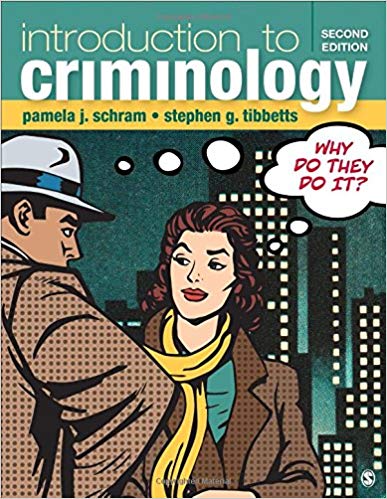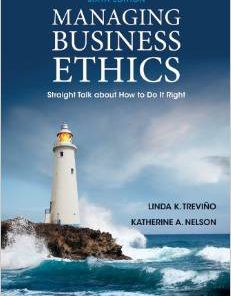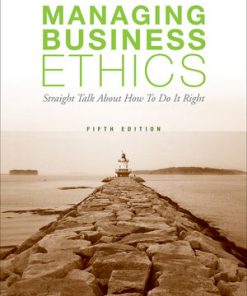Test Bank for Introduction to Criminology: Why Do They Do It? Second Edition
$35.00 Original price was: $35.00.$26.50Current price is: $26.50.
Test Bank for Introduction to Criminology: Why Do They Do It? Second Edition
Instant download Test Bank for Introduction to Criminology: Why Do They Do It? Second Edition pdf docx epub after payment.

Product details:
- ISBN-10 : 1506378439
- ISBN-13 : 978-1506378435
- Author: Pamela Schram; Stephen G. Tibbetts
Introduction to Criminology, Why Do They Do It?, Second Edition, by Pamela J. Schram Stephen G. Tibbetts, offers a contemporary and integrated discussion of the key theories that help us understand crime in the 21st century. With a focus on why offenders commit crimes, this bestseller skillfully engages students with real-world cases and examples to help students explore the fundamentals of criminology. To better align with how instructors actually teach this course, coverage of violent and property crimes has been integrated into the theory chapters, so students can clearly understand the application of theory to criminal behavior.
Table of contents:
Preface
Acknowledgments
About the Authors
Chapter 1: Introduction to Criminology
Introduction
Key Concepts to Understanding Criminology
The Criminal Justice System
Criminology Theory
Victimology
Conclusion
Key Terms
Discussion Questions
Web Resources
Chapter 2: Measuring Crime
Introduction
Crime Data From Law Enforcement Agencies
Crime Data from Victims of Crime: The National Crime Victimization Survey
Crime Data from Self-Report Surveys
Additional Approaches to Collecting Crime Data
Conclusion
Key Terms
Discussion Questions
Web resources
Chapter 3: Classical School of Criminology Thought
Introduction
Pre-Classical Perspectives of Crime and Punishment
The Age of Enlightenment
The Classical School of Criminology
Impact of Beccaria’s Work on Other Theorists
The Neoclassical School of Criminology
Loss of Dominance of Classical/ Neoclassical Theory
Policy Implications
Conclusion
Summary of Theories in Chapter 3
Key Terms
Discussion Questions
Web Resources
Chapter 4: Contemporary Classical and Deterrence Research
Introduction
Rebirth of Deterrence Theory and Contemporary Research
Rational Choice Theory
Routine Activities Theory
Policy Implications
Conclusion
Summary of Theories in Chapter 4
Key Terms
Discussion Questions
Web Resources
Chapter 5: Early Positivism
Introduction
Early Biological Theories of Behavior
Physiognomy
Lombroso’s Theory of Atavism and Born Criminals
AFTER Lombroso: The IQ-Testing Era
Body Type Theory: Sheldon’s Model of Somatotyping
Policy Implications
Case Study Revisited: Javier
Conclusion
Summary of Theories in Chapter 5
Key Terms
Discussion Questions
Web Resources
Chapter 6: Modern Biosocial Perspectives of Criminal Behavior
Introduction
Nature Versus Nurture: Studies Examining the Influence of Genetics and Environment
Cytogenetic Studies: The XYY Factor
Hormones and Neurotransmitters: Chemicals That Determine Criminal Behavior
Brain Injuries
Central and Autonomic Nervous System Activity
Biosocial Approaches Toward Explaining Criminal Behavior
Policy Implications
Conclusion
Summary of Theories in Chapter 6
Key Terms
Discussion Questions
Web Resources
Chapter 7: Psychological/ Trait Theories of Crime
Introduction
Early Psychological Theorizing Regarding Criminal Behavior
John Bowlby: Attachment Theory
Mental Health and the Criminal Justice System
Conclusion
Summary of Theories in Chapter 7
Key Terms
Discussion Questions
Web Resources
Chapter 8: Social Structure Theories of Crime I
Introduction
Early Theories of Social Structure: Early to Late 1800s
Durkheim and the Concept of Anomie
Merton’s Strain Theory
Variations of Merton’s Strain Theory
General Strain Theory
Summary of Strain Theories
Policy Implications of Strain Theory
Conclusion
Summary of Theories in Chapter 8
Key Terms
Discussion Questions
Web Resources
Chapter 9: Social Structure Theories of Crime II
Introduction
The Ecological School and the Chicago School of Criminology
Shaw and Mc Kay’s Theory of Social Disorganization
Cultural and Subcultural Theories of Crime
Criticisms of Cultural Theories of Crime
Policy Implications
Conclusion
Summary of Theories in Chapter 9
Discussion Questions
Web Resources
Key Terms
Chapter 10: Social Process and Control Theories of Crime
Introduction
Learning Theories
Differential Reinforcement Theory
Psychological Learning Models
Neutralization Theory
Control Theories
Early Control Theories of Human Behavior
Early Control Theories of Crime
Modern Social Control Theories
Integrated Social Control Theories
A General Theory of Crime: Low Self-Control
Conclusion
Summary of Theories in Chapter 10
Key Terms
Discussion Questions
Web Resources
People also search:
Introduction to Criminology: Why Do They Do It? Second Edition
Introduction to Criminology: Why Do They Do It? Second Edition pdf
Introduction to Criminology: Why Do They Do It?
what is the introduction of criminology
|
introduction to criminology why do they do it pdf
|
You may also like…
Solution Manual
Solution Manual for Corporate Finance Linking Theory to What Companies Do 3rd Edition by Graham












